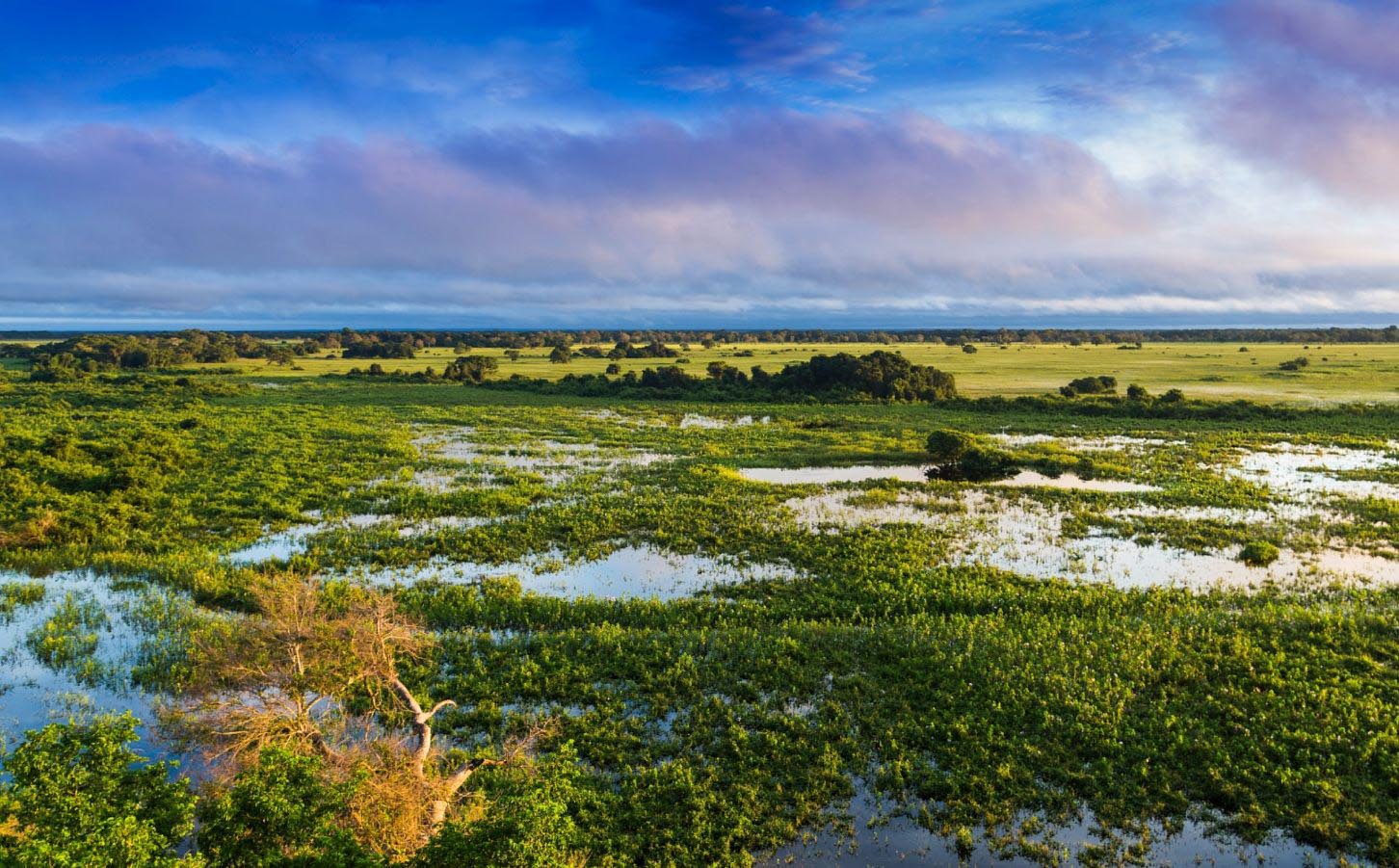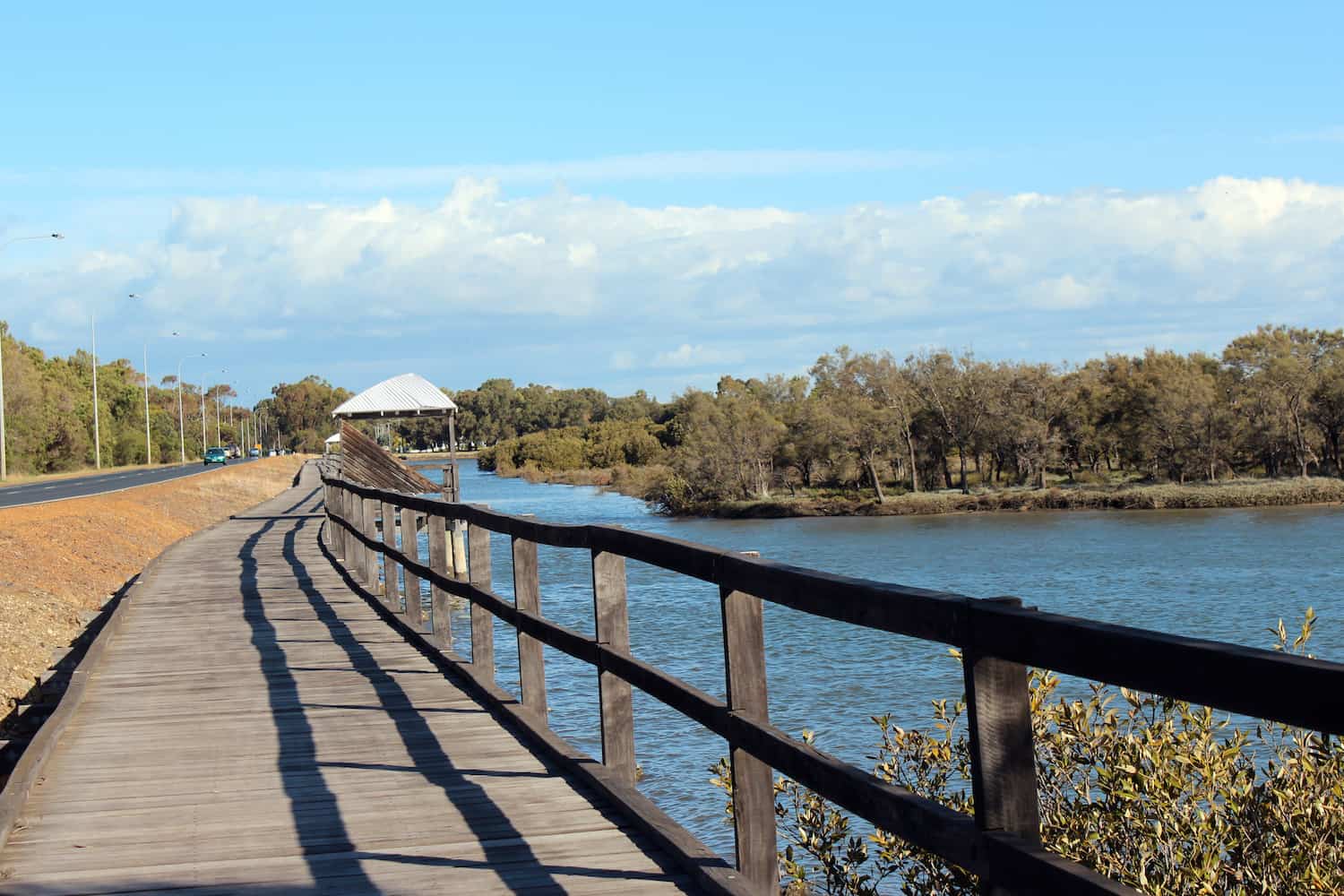Home>Garden Essentials>What Does Wetland Infill Mean


Garden Essentials
What Does Wetland Infill Mean
Modified: March 7, 2024
Discover what wetland infill means and its impact on gardens. Learn how to create a garden in wetland areas, maximizing biodiversity and sustainability.
(Many of the links in this article redirect to a specific reviewed product. Your purchase of these products through affiliate links helps to generate commission for Storables.com, at no extra cost. Learn more)
Introduction:
In our natural landscape, wetlands play a crucial role in maintaining a delicate ecological balance. These unique ecosystems are home to a diverse range of plant and animal species, providing habitat, flood control, water purification, and recreational opportunities for humans. However, the increasing demand for developable land has led to the practice of wetland infill, raising concerns about its potential environmental impacts.
Wetland infill refers to the process of filling in or reclaiming wetlands to create new land for construction, agriculture, or other purposes. This involves draining the wetland area and replacing it with soil, sand, or other materials to raise the surface elevation. However, this practice has raised significant environmental concerns due to the loss of critical wetland functions and the potential disruption of delicate ecosystems.
Understanding the concept of wetland infill is crucial to comprehend its implications and the need for careful management. This article aims to delve into the definition of wetland infill, explore the reasons behind its implementation, discuss its environmental impacts, examine the legal and regulatory considerations, and showcase some case studies. Additionally, mitigation measures for wetland infill will be highlighted to explore potential solutions to minimize its adverse effects.
It is important to note that wetland infill is a controversial topic, and opinions may vary among experts and stakeholders. While some argue for the economic benefits and land development opportunities it presents, others emphasize the importance of conserving and protecting these valuable ecosystems. This article aims to present a balanced view of wetland infill, taking into account different perspectives and scientific evidence to foster a comprehensive understanding of this practice.
Key Takeaways:
- Wetland infill involves filling in wetland areas for urban expansion, agriculture, and development, leading to habitat loss, water quality impacts, and flooding risks, highlighting the need for responsible land management and conservation efforts.
- Legal regulations, public participation, and mitigation measures such as wetland restoration and green infrastructure play a crucial role in minimizing the environmental impacts of wetland infill, emphasizing the importance of balancing human needs with ecosystem preservation.
Read more: What Does Combine Infill Mean
Definition of Wetland Infill:
Wetland infill, also known as wetland filling or wetland reclamation, refers to the process of altering or modifying a wetland by filling in the area with soil, gravel, rocks, sand, or other materials. This practice aims to raise the elevation of the wetland, effectively transforming it into upland or non-wetland habitat.
Wetland infill is typically carried out to create developable land for various purposes such as urban expansion, agriculture, infrastructure development, or industrial activities. It involves draining the wetland area by diverting or manipulating water sources and then replacing the water with fill material.
There are various forms of wetland infill, ranging from complete infilling where the entire wetland is filled, to partial infill where only certain areas within the wetland are filled. Fill materials can vary, but they are typically sourced locally and must meet specific engineering and construction standards to ensure stability and longevity.
It is important to note that wetland infill is distinct from wetland creation or restoration, which involves the intentional efforts to establish or rebuild wetlands in areas where they have been lost or degraded. While wetland creation and restoration focus on enhancing the ecological functions and biodiversity of wetlands, wetland infill involves their destruction or alteration for non-wetland purposes.
Wetland infill projects must often obtain permits and undergo environmental impact assessments to ensure compliance with local, regional, and national regulations. These regulations aim to protect wetland ecosystems and mitigate any potential adverse effects resulting from the infilling process.
Understanding the definition of wetland infill is crucial in addressing the potential consequences associated with this practice. This article will explore the reasons behind wetland infill, its environmental impacts, legal considerations, case studies, and mitigation measures in order to provide a comprehensive overview of this controversial issue.
Reasons for Wetland Infill:
There are several reasons why wetland infill is pursued as a land management practice. These reasons vary depending on the specific needs and priorities of the stakeholders involved. However, common factors driving wetland infill include:
- Urban Expansion: As population growth and urbanization continue to accelerate, there is a constant demand for additional land to accommodate residential, commercial, and industrial development. Since wetlands are often located in desirable locations due to their proximity to water bodies, they become prime targets for infill to create space for urban expansion.
- Agricultural Conversion: Wetlands are occasionally converted into agricultural land to meet the growing demand for food production. The fertile soils found in wetlands make them attractive for farming activities. However, this conversion can result in the loss of valuable wetland habitats and the associated ecosystem services they provide, such as water filtration and wildlife habitat.
- Infrastructure Development: Wetlands may need to be filled to construct infrastructures such as roads, airports, ports, and other transportation facilities. These projects aim to enhance connectivity and facilitate economic growth. However, the filling of wetlands can disrupt the natural hydrology of the area, impacting water drainage patterns and potentially causing flooding or water quality issues.
- Commercial and Industrial Activities: Wetland infill may be pursued to make way for commercial or industrial activities, such as shopping centers, factories, or warehouses. These projects are often driven by economic considerations, job creation, and the need for convenient access to markets. Nevertheless, the loss of wetland ecosystems can lead to the decline or displacement of unique plant and animal species, as well as the loss of other ecosystem functions.
- Land Reclamation: In some cases, wetland infill is undertaken for land reclamation purposes. This involves transforming coastal or tidal wetlands into dry land for coastal protection, housing, or tourism development. While land reclamation projects can be economically beneficial, they can also result in the loss of valuable coastal wetland habitats, which serve as buffer zones against storms, provide nurseries for fish, and maintain water quality.
It is important to recognize that the reasons for wetland infill are often complex and involve trade-offs between development and conservation. Striking a balance between fulfilling human needs and conserving vital wetland ecosystems is crucial to mitigate the potential long-term impacts of wetland infill and ensure sustainable land management practices.
Environmental Impacts of Wetland Infill:
Wetland infill can have significant and far-reaching environmental impacts due to the loss of critical wetland functions and the disruption of delicate ecosystems. The following are some of the main environmental implications associated with wetland infill:
- Habitat Loss: Wetlands are home to a diverse range of plant and animal species, many of which rely on these unique ecosystems for their survival. When wetlands are filled in, these habitats are destroyed, leading to the loss of specialized wetland species. This reduction in biodiversity can have cascading effects on the overall ecosystem health and can result in the displacement or extinction of wetland-dependent species.
- Water Quality Impacts: Wetlands play a crucial role in filtering and purifying water. As water flows through wetland systems, pollutants and excess nutrients are absorbed and transformed, improving water quality downstream. When wetland infill occurs, this natural filtration process is disrupted. Consequently, there is an increased risk of water pollution and degradation of downstream water bodies.
- Flooding and Drainage: Wetlands act as natural buffers against floods and storm surges by absorbing excess water during heavy rainfall or high tides. When wetlands are filled in, their ability to store and retain water is diminished, leading to increased runoff and a higher risk of flooding in surrounding areas. Additionally, the alteration of wetland hydrology can interrupt natural drainage patterns, exacerbating flood risks and potentially impacting water availability for neighboring ecosystems and communities.
- Loss of Carbon Storage: Wetlands, especially peatlands, are significant carbon sinks, capable of sequestering large amounts of carbon dioxide from the atmosphere. However, when wetlands are filled and drained, the organic materials in the soil decompose, releasing stored carbon into the atmosphere. This contributes to greenhouse gas emissions and exacerbates climate change.
- Disruption of Natural Processes: Wetlands perform important ecological functions, such as nutrient cycling, sediment trapping, and providing habitat for migratory birds. The infilling of wetlands disrupts these natural processes, impacting the overall ecosystem dynamics. Alterations to nutrient cycling can lead to imbalances in nutrient availability, affecting plant and aquatic life. The loss of sediment trapping capability can result in increased sedimentation and erosion downstream, further impacting aquatic ecosystems.
It is essential to recognize the cumulative and interconnected nature of the environmental impacts of wetland infill. While individual infill projects may seem relatively small-scale, their collective effects over time can be significant, leading to the degradation and loss of valuable wetland ecosystems. Therefore, it is crucial to consider the long-term ecological consequences and explore alternative approaches to land use and development that prioritize the preservation and restoration of wetland habitats.
Legal and Regulatory Considerations:
Due to the environmental importance of wetlands, there are laws and regulations in place at various levels of government to govern wetland infill activities. These legal frameworks aim to protect wetland ecosystems, ensure responsible land use practices, and mitigate the potential impacts of wetland infill. Here are some significant legal and regulatory considerations:
- National and International Legislation: Many countries have national legislation in place to protect wetlands. For example, the United States has the Clean Water Act and the National Environmental Policy Act, which provide guidelines and regulations for wetland preservation and permitting for wetland infill projects. Internationally, the Ramsar Convention is a treaty that aims to conserve and sustainably use wetlands of international importance. These legal instruments provide a framework for wetland protection and raise awareness of the value of wetlands globally.
- Permitting Processes: Wetland infill projects often require permits from relevant governmental agencies. These permits help assess the potential impacts of the infill on wetland ecosystems and ensure compliance with environmental regulations. The permitting process typically involves conducting environmental impact assessments, which evaluate the ecological, hydrological, and socio-economic consequences of the infill. Permitting requirements can vary by jurisdiction, and adherence to prescribed regulations is essential to avoid legal penalties and ensure responsible land development practices.
- Mitigation Measures: In some cases, wetland infill projects may be allowed under certain conditions if adequate mitigation measures are implemented. Mitigation may involve creating or restoring wetlands elsewhere to compensate for the loss of wetland functions. These compensatory wetlands should be carefully designed to provide similar ecological services and mitigate the overall impact of the infill. The effectiveness of mitigation measures and their long-term monitoring are critical to ensure successful restoration and the mitigation of impacts resulting from wetland infill.
- Critical Habitat Designations: Some wetland areas may receive special designations as critical habitats for endangered or threatened species. These designations confer additional legal protection to these areas and may impose stricter regulations on wetland infill activities. Developers and landowners must navigate these regulations to ensure compliance and avoid penalties relating to the destruction or disturbance of designated critical habitats.
- Public Participation: Many legal frameworks emphasize the importance of public engagement and participation in decision-making processes related to wetland infill projects. Community input, stakeholder consultations, and public hearings provide opportunities for concerned individuals and organizations to express their opinions, present alternative perspectives, and influence the outcome of proposed infill projects. Public participation helps ensure transparency, accountability, and the consideration of diverse viewpoints in the decision-making process.
Understanding and adhering to the legal and regulatory considerations surrounding wetland infill is essential for responsible land development and the sustainable management of wetland ecosystems. Effective implementation and enforcement of these regulations, along with regular monitoring and evaluation, play a crucial role in minimizing the adverse impacts of wetland infill and protecting these valuable ecological resources.
Wetland infill refers to the process of filling in a wetland area with soil or other materials. This can have negative impacts on the environment, including loss of habitat for wildlife and increased risk of flooding. It’s important to protect and preserve wetlands for their ecological value.
Read more: What Infill Does Shapeways Print With
Case Studies of Wetland Infill Projects:
Examining real-life examples of wetland infill projects can provide valuable insights into the environmental, social, and economic implications of this practice. While each case study is unique, they collectively shed light on the challenges and controversies associated with wetland infill. Here are a few notable examples:
- San Francisco Bay, California, USA: The San Francisco Bay area has experienced extensive wetland infill due to rapid urbanization and land development. Historical records indicate that over 90% of the original wetlands in the region have been lost to human activities. Wetland infill projects for real estate development and port expansion have significantly altered the natural landscape, impacting important migratory bird habitats and exacerbating flooding risks. Efforts are currently underway to restore and protect remaining wetlands in the area.
- Punggol and Tuas, Singapore: Singapore, a densely populated city-state known for its land scarcity, has pursued extensive wetland infill projects for land reclamation. The Punggol and Tuas areas are prime examples, where vast stretches of coastal and mangrove wetlands have been filled to create residential and industrial spaces. These projects have caused the loss of critical habitats, impacted biodiversity, and altered coastal dynamics. To mitigate the environmental impact, Singapore has implemented comprehensive strategies for ecosystem management, including the creation of artificial wetlands and biodiversity enhancement programs.
- The Everglades, Florida, USA: The Everglades, a unique wetland ecosystem in Florida, has faced significant challenges due to wetland infill. Drainage and canal construction for urban development, agriculture, and flood control purposes have disrupted the natural hydrology of the area, leading to the loss of wetland habitats and an array of environmental issues such as water pollution, habitat degradation, and altered ecological processes. Restoration efforts, such as the Comprehensive Everglades Restoration Plan, are underway to restore the natural flow of water and revive the ecological integrity of the Everglades.
- Murujuga, Western Australia: Murujuga, also known as the Burrup Peninsula, is home to one of the world’s most significant collections of ancient rock art, as well as unique flora and fauna. The expansion of industry and resource extraction in the region has resulted in wetland infill and land degradation. This has raised concerns about the impact on the cultural significance of the area and the potential loss of habitat for native species. Efforts are underway to balance industrial development with conservation priorities, including the establishment of a conservation park and increased awareness of the importance of preserving the cultural and ecological values of the site.
- Chongming Dongtan, Shanghai, China: Chongming Dongtan, an important coastal wetland in Shanghai, has experienced extensive wetland infill for land reclamation and urban development. The loss of wetland habitats has impacted migratory bird populations and disrupted the natural flood control capacities of the area. In response, conservation initiatives and the establishment of protected areas have been implemented to preserve the remaining wetlands and restore ecological connectivity within the region.
These case studies highlight the diverse contexts and challenges associated with wetland infill projects. They underline the importance of considering environmental, cultural, and social factors in land development decisions and the need for responsible and sustainable approaches to wetland management.
Mitigation Measures for Wetland Infill:
Given the potential adverse impacts of wetland infill, it is crucial to implement effective mitigation measures to minimize environmental harm and ensure the long-term sustainability of land development projects. These measures aim to offset the loss of wetland functions and biodiversity. Here are some common mitigation strategies employed to mitigate the impacts of wetland infill:
- Wetland Creation or Restoration: One of the most effective mitigation measures is the creation or restoration of wetlands in alternative locations. This involves constructing new wetland habitats that mimic the original wetland functions and provide suitable habitats for wetland-dependent species. By compensating for the loss of wetlands through infill projects, these new or restored wetlands can help maintain hydrological connectivity, enhance biodiversity, and provide ecosystem services.
- Compensatory Mitigation: Compensatory mitigation involves providing compensation for the loss of wetland ecosystems by enhancing or protecting existing wetlands. This can be achieved through measures such as acquiring and conserving nearby wetland areas with similar ecological characteristics or implementing conservation easements to ensure the long-term protection of critical wetland habitats. Compensatory mitigation aims to maintain or enhance ecosystem services and functions, promoting the overall sustainability of wetland landscapes.
- Green Infrastructure and Stormwater Management: Incorporating green infrastructure techniques in the design of urban developments can help mitigate the impacts of wetland infill. These techniques include the use of permeable pavements, bioswales, and retention ponds to mimic natural water storage and filtration processes. By integrating green infrastructure systems, the negative effects of altered hydrology can be minimized, reducing flood risks, improving water quality, and providing habitat for urban wildlife.
- Conservation and Land Use Planning: Implementing comprehensive conservation and land use planning strategies can help identify and protect critical wetland areas from potential infill activities. This involves establishing protected areas, conservation easements, or zoning regulations that prioritize the preservation of wetlands. By designating areas as off-limits to development, these measures ensure the conservation of high-value wetlands and their associated ecological functions.
- Environmental Monitoring and Management: Regular monitoring and management of wetland infill projects are crucial to ensure compliance with environmental regulations and the effectiveness of mitigation measures. Implementing monitoring programs that assess changes in water quality, biodiversity, and habitat conditions can provide valuable data on the success of mitigation efforts. Adjustments can be made as needed to enhance the long-term ecological outcomes of wetland infill projects.
It is important to note that successful implementation of mitigation measures requires collaboration between various stakeholders, including developers, environmental agencies, community organizations, and indigenous peoples. By working together, it is possible to strike a balance between land development and the preservation of valuable wetland ecosystems.
While mitigation measures can help reduce the environmental impacts of wetland infill, it is important to acknowledge that they cannot fully replace the ecological functions and services provided by natural wetlands. Therefore, a proactive approach that prioritizes the preservation and restoration of wetlands is crucial to minimize the need for wetland infill and ensure the long-term sustainability of our ecosystems.
Conclusion:
Wetland infill is a contentious practice that involves filling in wetland areas to create developable land for various purposes. While it can address the growing demand for space and economic development, wetland infill comes with significant environmental consequences that cannot be overlooked.
Throughout this article, we have explored the definition of wetland infill, the reasons driving its implementation, the environmental impacts it brings, the legal and regulatory considerations surrounding it, and several case studies exemplifying its effects. We have also explored mitigation measures that aim to offset the environmental harm caused by wetland infill.
It is clear that wetland infill results in the loss of critical wetland habitats, which in turn leads to the displacement of plant and animal species, water quality issues, increased flood risks, carbon emissions, and disruption of ecological processes. These impacts highlight the urgent need for responsible and sustainable land management practices that prioritize the preservation and restoration of wetland ecosystems.
Legal and regulatory considerations play a pivotal role in mitigating the impacts of wetland infill. National and international legislation, permitting processes, and public participation are all crucial components of a comprehensive framework that helps ensure compliance with environmental regulations and fosters sustainable decision-making.
Furthermore, mitigation measures such as wetland creation or restoration, compensatory mitigation, green infrastructure, and environmental monitoring contribute significantly to minimizing the negative effects of wetland infill. These measures provide alternatives that help maintain wetland functions, enhance biodiversity, improve water quality, and reduce flood risks.
In conclusion, striking a balance between land development for human needs and the protection of wetland ecosystems is paramount. Through integrated planning, responsible land use practices, and a proactive approach to conservation, we can minimize the need for wetland infill and safeguard the invaluable ecological services provided by wetlands.
As stewards of the environment, we must recognize the importance of wetlands in maintaining biodiversity, promoting water quality, and supporting numerous ecosystem services. By preserving and restoring wetlands, we can ensure a sustainable future for both humans and the natural world.
References:
1. Environment Agency. (2021). Wetland Creation and Restoration. Retrieved from https://www.gov.uk/guidance/wetland-creation-and-restoration
2. Ramsar Convention. (2021). Ramsar Wetland Conservation. Retrieved from https://www.ramsar.org/
3. United States Environmental Protection Agency. (2021). Wetland Mitigation. Retrieved from https://www.epa.gov/wetlands/wetland-mitigation
4. U.S. Fish and Wildlife Service. (2021). Wetland Mitigation Banking. Retrieved from https://www.fws.gov/wetlands/documents/bankingbrochure/BnkBrochure.pdf
5. World Wildlife Fund. (2021). Wetland Conversion and Infill. Retrieved from https://www.worldwildlife.org/threats/wetland-conversion-and-infill
6. World Wildlife Fund. (2021). Wetlands and Climate Change. Retrieved from https://www.worldwildlife.org/initiatives/wetlands-and-climate-change
7. Xing, H., Luo, J., Sun, Z., & Huang, X. (2021). Ecological Impacts of Coastal Wetland Infilling in Shanghai, China: A Case Study of Chongming Dongtan. Wetlands, 41(1), 35-47. doi: 10.1007/s13157-020-01383-z
8. Yang, Z., Tam, N. F., & Lan, C. (2020). Environmental Impacts of Land Reclamation and Alternatives for Development in Coastal Areas: A Review. Journal of Environmental Management, 269, 110814. doi: 10.1016/j.jenvman.2020.110814
9. Zedler, J. B., & Kercher, S. (2005). Wetland Resources: Status, Trends, Ecosystem Services, and Restorability. Annual Review of Environment and Resources, 30, 39-74. doi: 10.1146/annurev.energy.30.050504.144248
10. Zheng, Z., & Liu, Y. (2021). A Comparative Study of Legal Systems for Wetland Protection. Journal of Environmental Law and Practice, 34(4), 625-646. doi: 10.3389/fevo.2021.792171
Frequently Asked Questions about What Does Wetland Infill Mean
Was this page helpful?
At Storables.com, we guarantee accurate and reliable information. Our content, validated by Expert Board Contributors, is crafted following stringent Editorial Policies. We're committed to providing you with well-researched, expert-backed insights for all your informational needs.















0 thoughts on “What Does Wetland Infill Mean”